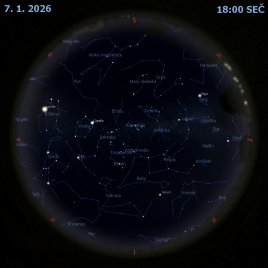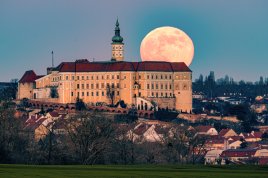Mlhovina Wolfova jeskyně

Uznání a copyright: Gianni Lacroce
Tajemná modrá reflexní mlhovina označovaná v katalozích jako VdB 152 nebo Ced 201 je opravdu velice slabá. Nachází se na špičce dlouhé temné mlhoviny Barnard 175 v prachovém komplexu, kterému se také říká Wolfova jeskyně. Kosmická zjevení ve středu tohoto hlubokého teleskopického pohledu jsou téměř 1400 světelných roků daleko v severní Mléčné dráze v královském souhvězdí Kefeus (Cepheus). Mezihvězdný prach v této oblastí cloní světlo hvězd v pozadí a rozptyluje světlo ze zanořené jasné hvězdy, která dává konci této mlhoviny její charakteristickou modrou barvu. I když hvězdy vznikají v molekulárních mračnech, tak se zdá, že tato hvězda do této oblasti jenom náhodou přivandrovala, jelikož její změřená prostorová rychlost se velice liší od rychlosti mračna. Dole na snímku je planetární mlhovina Dengel-Hartl 5 a na pravé straně snímku je také vidět červeně zářící plyn ze zbytku starodávné supernovy.
Seznam odkazů v popisu
- Harvard.edu: A New "Cave-Nebula" in Cepheus
- NOIRLab.edu: vdB 152, Barnard 175
- APOD: 2009-04-25 Tmavé značení na obloze
- Bf-Astro.com: Focal Pointe Observatory - Astrophotography by Bob Franke: vdB 152
- APOD: 2020-10-26 Reflexe Duchovité mlhoviny
- Flickr.com: Gianni Lacroce: Wolf's Cave Nebula lbn 528 ha-rbg
- NASA: What is a light-year?
- EarthSky.org: Constellation Cepheus looks like a house
- NASA: Interstellar Dust Particles
- APOD: 2020-11-22 Tmavé molekulární mračno Barnard 68
- Wikipedia: Reflection_nebula
- CalTech.edu: Star Birth
- Wikipedia: Molecular_cloud
- AstroBin.com: Gianni Lacroce :Wolf's Cave Nebula lbn 528 ha-rbg
- AstrodonImaging.com: Dengel-Hartl 5 in Cepheus
- Bf-Astro.com: Focal Pointe Observatory - Astrophotography by Bob Franke: vdB 152
NASA Official: Phillip Newman Specific rights apply. NASA Web Privacy Policy and Important Notices
A service of: ASD at NASA / GSFC & Michigan Tech. U.
Odkaz na originální APOD


